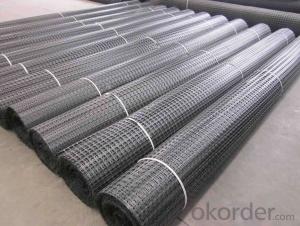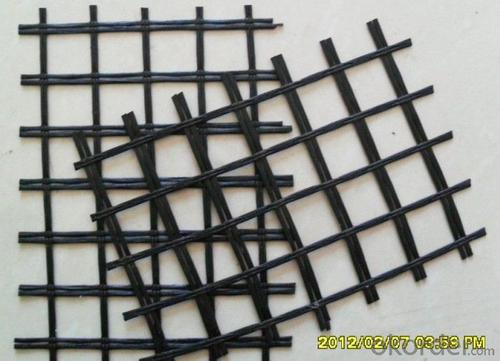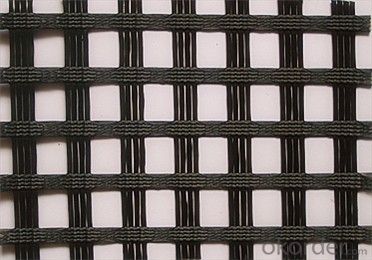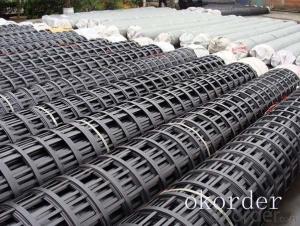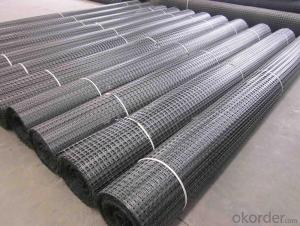Tencate Mirafi Geogrids 50/50kn/m Warp Knitted Fiberglass Geogrid in China
- Loading Port:
- Qingdao
- Payment Terms:
- TT OR LC
- Min Order Qty:
- 30000 m²
- Supply Capability:
- 500000 m²/month
OKorder Service Pledge
OKorder Financial Service
You Might Also Like
Structure of 50/50Kn/M Warp Knitted Fiberglass Geogrid:
Warp Knitted Fiberglass Geogrid is to select high quality enhanced non-alkali fiberglass yarn,and it uses foreign advanced warp knitting woven to become the base materials.Using the warp knitting oriented structure to make full use of the fabric yam strength and improve its mechanical properties ,so it makes good tensile strength ,tearing strength and resistance to creep properties of modified asphalt,and through high quality coating is handled and become planar finely materials.
Main Features of 50/50Kn/M Warp Knitted Fiberglass Geogrid:
fiberglass geogrid for soil reinforcement
fiberglass geogrid
High intension,high tenacity,high occlusive force with soil or gravel,erosion-resistant,water drainage,light weigth.
Reinforce soft soil roadbed,rib side slope of embankment,enhance isolation,inhibit ground deformation,prevent crack by reflection,incre
High tensile strength, low elongation
High stability
Warp Knitted Fiberglass Geogrid Images



Warp Knitted Fiberglass Geogrid specifiction
Glass Fiber Geogrid GGF80 Technical Specification | |||
Property | Test Method | Unit | Index |
Wide Width Tensile Strength | |||
MD | KN/M | ≥80 | |
CMD | KN/M | ≥80 | |
Elongation At Break | ≤4 | ||
Grid | MM | 25.4×25.4 | |
Width | M | 1~6 | |
Packaging | Details | ||
Roll Dimensions(W×L) | According to customer requirements | ||
Square Meters Per Roll | |||
Estimated Roll Weight | |||
It is widely used in Asphalt wall, railway foundation, dike slope, runway and sand harnessing.
FAQ
We have organized several common questions for our clients,may help you sincerely:
Q: How about your company?
A:Our company are one of the largest geosynthetic products supplier in the world.We have the products experience more than 20 years.Already export to USA/Germeny/Australia/Zambia/Brazil etc.more than 20 countries.Almost 10years.Our products including Geocell/Fiberglass Geogrid/Geomembrane/Geotextile/Geonet etc.
Q.Does your products have good qualitity?
A:Yes,we have do many big projects such as the 2008 Beijing Olympic BIRD NEST. Divert water from the south to the north project. And our products have CE certificate also.
Q:How long can we receive the products after purchase?
A:In the purchase of product within three working days, We will arrange the factory delivery as soon as possible. The pecific time of receiving is related to the state and position of customers.Commonly 15-20 working days can be delivery.
- Q: What is the main purpose of unidirectional plastic geogrid?Plastic geogrid production
- Unidirectional geogrid reinforced asphalt pavement or cement: Geogrid laying layer at the bottom of asphalt or cement, can reduce rutting depth, prolong the fatigue life of the pavement, but also can reduce the asphalt or cement pavement thickness, in order to save costs.For road slope and dam reinforcement and retaining wall: the traditional embankment especially filling high embankment filling and often need to shoulder edge easy compaction, resulting in slope rainwater invasion, collapse instability phenomena have occurred, but with a gentle slope, covers an area of large, the retaining wall has the same the problem of using geogrid embankment slope or retaining wall reinforcement can be reduced by two points a area, prolong service life, reduce the cost of 20 - 50%.
- Q: What are the different materials used to manufacture geogrids?
- Geogrids are manufactured using various materials such as polyester, polypropylene, high-density polyethylene (HDPE), and fiberglass. These materials offer different strengths, durability, and chemical resistances, allowing geogrids to be customized for various applications in civil engineering and construction projects.
- Q: Can geogrids be used in erosion control blankets?
- Yes, geogrids can be used in erosion control blankets. Geogrids provide additional strength and stability to erosion control blankets, helping to prevent soil erosion and promote vegetation growth in areas prone to erosion.
- Q: How do geogrids improve the performance of geocellular systems?
- Geogrids improve the performance of geocellular systems by providing structural reinforcement and stability. They help distribute loads more evenly across the system, preventing localized stress and potential failure. Geogrids also enhance the interlocking of cells, increasing the overall load-bearing capacity and reducing the likelihood of deformation or settlement. Additionally, these grids enhance drainage within the system, allowing for efficient water flow and preventing water accumulation. Overall, geogrids significantly enhance the durability and long-term performance of geocellular systems.
- Q: Physical characteristics of geogrid construction method
- 1, with a strong tensile strength, tensile strength in the range of 25-110kn/m, according to the product model is not the same, tensile strength is not the same.2, the stress elongation is small, the structure has a good lateral stability and enhance the ability.3, high physical and chemical stability, anti-aging, anti soil burial, good corrosion resistance.4, the friction coefficient is large, the net structure is fully integrated into the earth and rock structure to enhance the stability of the structure.5, the resistance to environmental stress is strong, when the stress is enhanced with a small amount of deformation, in the -20 to 120 degrees centigrade range of temperature deformation coefficient is small.6, the width of the general 4 -6 meters, light installation construction is simple and convenient, efficient, economic.
- Q: How do geogrids improve the performance of geotextile sediment retention tubes?
- Geogrids improve the performance of geotextile sediment retention tubes by providing additional stability and reinforcement. They help to prevent the tubes from bulging or collapsing under the weight of sediment and water, thus maintaining their intended shape and functionality. Additionally, geogrids increase the overall strength of the system, enhancing its ability to retain sediment and resist erosion.
- Q: Are geogrids suitable for reinforcement of mechanically stabilized aggregate base layers?
- Yes, geogrids are suitable for reinforcement of mechanically stabilized aggregate base layers. Geogrids are designed to improve the strength and stability of soil or aggregate layers by distributing loads more efficiently and reducing lateral movement. They can enhance the performance and lifespan of mechanically stabilized aggregate base layers by increasing their load-bearing capacity, reducing rutting, and preventing the formation of cracks.
- Q: What is the recommended geogrid connection method for specific applications?
- The recommended geogrid connection method for specific applications depends on factors such as the type of soil, slope angle, and expected load conditions. Some common geogrid connection methods include mechanical connectors, welded connections, and soil wrap-around techniques. It is important to consult with a geotechnical engineer or follow manufacturer's recommendations to determine the most suitable connection method for a specific application.
- Q: Can geogrids be used in ground reinforcement for sports fields?
- Yes, geogrids can be used in ground reinforcement for sports fields. Geogrids provide stability, improve load-bearing capacity, and prevent soil erosion, making them a suitable choice for reinforcing the ground in sports fields and ensuring a durable playing surface.
- Q: Can geogrids be used in reinforced earth bridge abutments?
- Yes, geogrids can be used in reinforced earth bridge abutments. Geogrids are commonly used in the construction of bridge abutments as they provide reinforcement and stabilization to the soil. They help distribute the load and increase the overall strength of the structure, making it more resistant to settlement and lateral forces. Geogrids are an effective solution for enhancing the stability and durability of reinforced earth bridge abutments.
Send your message to us
Tencate Mirafi Geogrids 50/50kn/m Warp Knitted Fiberglass Geogrid in China
- Loading Port:
- Qingdao
- Payment Terms:
- TT OR LC
- Min Order Qty:
- 30000 m²
- Supply Capability:
- 500000 m²/month
OKorder Service Pledge
OKorder Financial Service
Similar products
Hot products
Hot Searches
Related keywords





